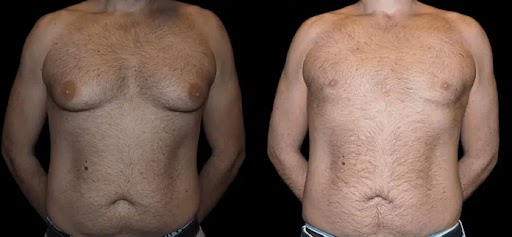Male breast reduction surgery is a common procedure for men dealing with gynecomastia, a condition that causes enlarged breasts. While the surgery offers relief and improved aesthetics, many patients are concerned about recovery and how soon they can resume their daily activities, especially returning to work. In this article, we’ll explore the recovery process, the different types of male breast reduction surgeries, and the factors influencing the timeline for getting back to work.
Understanding Male Breast Reduction Surgery
Male breast reduction in Dubai surgery typically involves the removal of excess fat, glandular tissue, and skin from the chest area. There are three primary techniques used:
Liposuction Technique: This method involves making small incisions and using a cannula to suction out excess fat. It is ideal for men with gynecomastia primarily caused by fatty tissue and minimal excess skin. The procedure is less invasive, and recovery is typically faster.
Excision Technique: This technique is used when glandular breast tissue or excess skin needs to be removed. It is more suitable for men with more severe cases of gynecomastia or when the nipple and areola need repositioning. The recovery period can be slightly longer compared to liposuction.
Combination of Liposuction and Excision Techniques: In some cases, both liposuction and excision are used to achieve the best results. This approach is common when both fatty and glandular tissues are present.
Each of these methods influences how soon you can return to work after male breast reduction surgery, and your surgeon will guide you based on the specific technique used.
Factors Affecting Recovery Time
Several factors determine how long it will take for you to return to work after your surgery:
- Type of Surgery: As mentioned, the method used for your male breast reduction will impact your recovery time. Liposuction tends to have a quicker recovery, while excision might take a bit longer.
- Extent of Surgery: The more extensive the procedure, the longer your recovery will be. For instance, if the surgery involves the removal of significant glandular tissue or skin, you may require more time to heal before returning to work.
- Your Overall Health: Patients in good health generally recover faster. Your age, immune system strength, and overall fitness level will all play a role in how soon you can resume daily activities.
- Nature of Your Job: The type of work you do will also impact your return-to-work timeline. If you have a physically demanding job, you may need more time before you can safely return. For desk jobs or work that requires minimal physical activity, the time off may be shorter.
Male Breast Reduction Cost in Dubai
The cost of male breast reduction surgery varies depending on several factors, including the surgeon’s expertise, the clinic’s reputation, and the complexity of the surgery. The male breast reduction cost in Dubai can range between AED 17,999 to AED 35,000. Consulting with a cosmetic surgery clinic in Dubai will help you get a detailed breakdown of costs and the factors influencing pricing. The best plastic surgeons in Dubai are known for their advanced techniques and patient care, ensuring you receive high-quality treatment for your condition.
Recovery Timeline: When Can You Go Back to Work?
First Few Days Post-Surgery
Immediately after surgery, patients are advised to rest. You may experience swelling, bruising, and discomfort in the chest area, which is normal. Most patients are given compression garments to wear, which aid in reducing swelling and speeding up the healing process. During the first 48 hours, you should focus on rest and avoid any strenuous activity. Pain medication prescribed by your doctor will help manage discomfort.
1 to 2 Weeks After Surgery
For those wondering, how soon can I return to work after male breast reduction surgery? The answer depends on how you feel after the first week. Most patients can return to non-strenuous desk jobs within 1 to 2 weeks. However, if your work involves physical activity, lifting heavy objects, or high mobility, you may need to extend this period to 3 to 4 weeks. It’s essential to avoid any actions that strain the chest muscles, as this could interfere with the healing process.
During this phase, you will likely have follow-up appointments with your surgeon to monitor your healing progress. Always follow the surgeon’s recommendations and avoid rushing your recovery.
3 to 4 Weeks After Surgery
Around the third to fourth week, swelling and bruising should start to subside significantly. By this time, you may feel comfortable enough to resume more activities, although high-impact exercises and heavy lifting should still be avoided. It’s crucial to follow your surgeon’s advice and continue wearing the compression garment as instructed to support your chest during recovery.
4 to 6 Weeks After Surgery
By the fourth to sixth week, most patients can resume their regular work routine, including physically demanding jobs, unless otherwise advised by their surgeon. You can also begin to slowly reintroduce light exercise, but strenuous workouts and heavy chest exercises should still be avoided until fully cleared by your doctor.
Final Recovery
Full recovery from male breast reduction surgery may take several months. Even if you feel physically better and are ready to return to work, complete internal healing can take time. Listening to your body and attending all follow-up appointments is critical to ensure proper healing.
Conclusion:
When considering any surgery, choosing the right surgeon and clinic is essential. The perfect doctors clinic or cosmetic surgery clinic in Dubai will ensure you receive the best care before, during, and after surgery. The best plastic surgeons in Dubai are experienced in male breast reduction surgery and will provide personalized recovery plans to help you get back to your daily life as quickly and safely as possible.
How soon can I return to work after male breast reduction surgery? It depends on your body’s healing process, the type of procedure, and the nature of your job. Always follow your surgeon’s post-operative instructions for a smooth and successful recovery.


